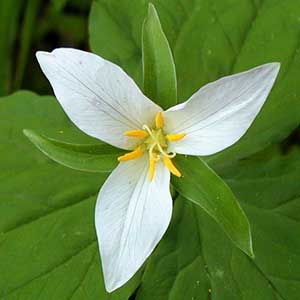Trillium viride
Trillium ovatum
green trillium, wood wakerobin
Pacific trillium, trillium, western trillium, western wake-robin, western white trillium, white or western trillium, white trillium
horizontal, brownish, short, slender to stout, praemorse, not brittle.
semierect to horizontal, short, stout, praemorse.
1–3, round in cross section, 2.3–3.4+ dm, ± slender, smooth to scabrous below bracts.
1–2, round, 2–5 dm, ± slender, glabrous.
held well above ground, sessile;
blade green to bluish green, weakly mottled, rarely unmottled, mottling becoming obscure with age, adaxial surface covered with numerous stomata easily visible under a lens, occasionally visible as tiny white dots to the naked eye, narrowly to broadly elliptic, 8–20.5 × 5–8 cm, not glossy, apex blunt to rounded-acute.
sessile, subsessile, or short-petiolate;
blade medium green, sometimes blotched and mottled, main veins prominent, ovate-rhombic, 7–12 × 5–20 cm, continuing to expand during anthesis, base rounded, apex acuminate.
erect, odor of decayed fruit;
sepals displayed above bracts, widely spreading, distal 1/2 often weakly declined, green, lanceolate-acute, 28–60 × 7–9 mm, margins entire, apex acute;
petals long-lasting, erect to widely spreading, ± connivent, ± concealing stamens and ovary, green, yellowish green, yellow, or variously purple streaked throughout, especially basally (rarely all purplish green), not spirally twisted, narrowly spatulate to linear-spatulate, 3.5–6.8 × 0.5–1.5 cm, widest above middle, thick-textured, base narrowed and thickened, ± forming claw, margins entire, apex obtuse, lacking nipple;
stamens relatively straight-erect to slightly incurved, 15–25 mm;
filaments brown-olive, 3–5.5 mm, dilated basally;
anthers erect, straight, olive-brown or purplish, 8–21 mm, ± slender, dehiscence introrse-latrorse;
connectives olive, straight, very slightly (± 0.5 mm) extended beyond sacs;
ovary greenish basally, olive-purplish distally, ellipsoid to ovoid, deeply angled, 5–12 mm;
stigmas spreading-erect, recurved, distinct, sessile, olive or purplish, subulate, 5–10 mm, somewhat fleshy.
erect or nodding, odorless;
sepals spreading to horizontal, green, lanceolate to oblong-lanceolate, 15–50 × 6–20 mm, margins entire, apex acute;
petals erect-ascending, usually wide-spreading from base, exposing entire pistil, white or with pink or blush markings, lacking V-shaped markings, fading to rosy pink, purple, or dark red, veins not deeply engraved, ± linear to widely obovate, 1.5–7 ×1–4 cm, widest at or above middle, thin-textured, margins flat to undulate, apex acuminate;
stamens prominent, slightly recurved-spreading to straight, 10–18 mm;
filaments white, shorter than anthers, slender;
anthers yellow, 4–16 mm, slender, dehiscence latrorse-introrse;
ovary green or white, ovoid, 6-angled, 5–12 mm, attachment ± 3/4 ovary width;
stigmas recurved, barely connate basally, greenish white or white, linear, not lobed adaxially, 6–10 mm, uniformly thin;
pedicel erect to leaning, 2–6 cm.
greenish white, odorless, ovoid, angled, 1–1.5 cm, somewhat pulpy, not juicy.
baccate, green or white, ± odorless, broadly ovoid, obscurely winged, 1.2–2.8 × 0.7–1.9 cm, pulpy-moist.
= 10.
= 10.
Trillium viride
Trillium ovatum
Trillium viride has long been confused with T. luteum of the Smoky Mountain region, though it is far more slender and delicate than T. luteum. Because the pallid forms and so-called albinos of many other sessile trilliums described in written accounts sound much like the description of this plant, early authors ascribed far too wide a range to T. viride. The plant is closely limited to the woodlands of the counties adjacent to the Missouri River in northeastern Missouri and southern Illinois.
Although the ranges of Trillium viride and the very similar T. viridescens do not overlap, both species grow in Missouri, and authors earlier than J. D. Freeman (1975) frequently combined the two as a single species. If all other means of identification fail, the prevalence of numerous stomates on the adaxial bract surface, seen under magnification, will always distinguish T. viride.
(Discussion copyrighted by Flora of North America; reprinted with permission.)
Varieties 2 (2 in the flora).
(Discussion copyrighted by Flora of North America; reprinted with permission.)
1. Bracts sessile; petals lanceolate to obovate, 1.5–7 × 1–4 cm | var. ovatum |
1. Bracts distinctly short-petiolate; petals linear to linear-lanceolate, 0.5–2.4 × 0.2–0.6 cm | var. oettingeri |
- Local floras:
BC,
CA,
OR,
WA
- Local Web sites:
CalFlora,
CalPhotos,
Flora NW,
PNW Herbaria,
Turner Photog.
WildflowerSearch
iNaturalist (observations)
USDA Plants Database
- LBJ Wildflower Center
- SEINet
- Plants of the World Online
- Encyclopedia of Life
- Wikipedia
- Google Image Search


